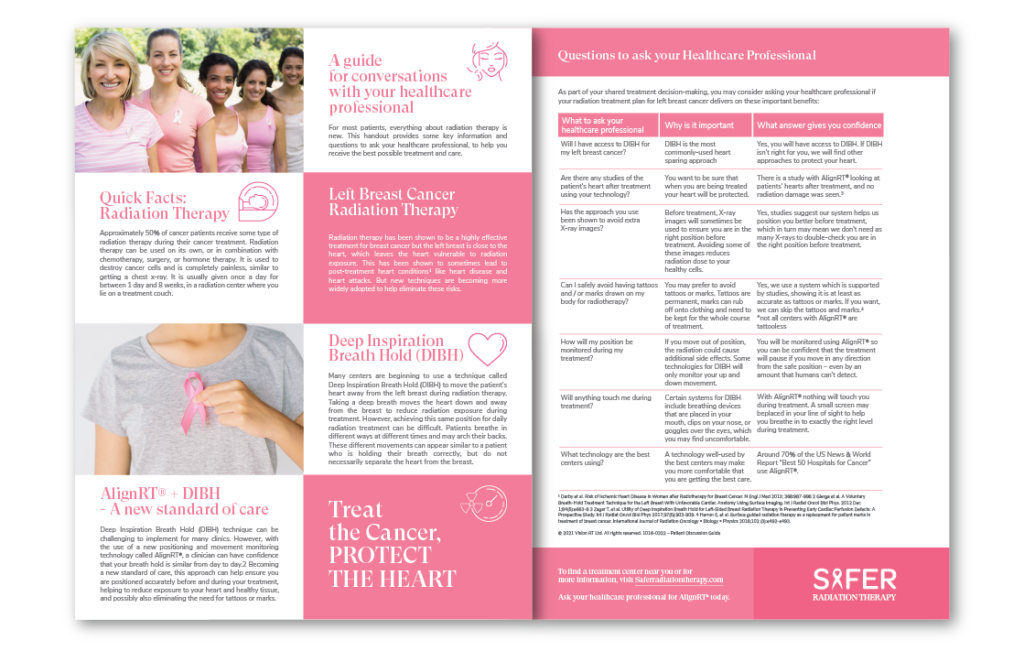Breast Cancer Patient Discussion Guide
A guide for conversations with your healthcare professional
For most patients, everything about radiation therapy is new. The information on this page provides some key information and questions to ask your healthcare professional, to help you receive the best possible treatment and care.
Please feel free to download this information to take with you to your next doctor’s appointment.
Approximately 50% of cancer patients receive some type of radiation therapy during their cancer treatment. Radiation therapy can be used on its own, or in combination with chemotherapy, surgery, or hormone therapy. It is used to destroy cancer cells and is completely painless, similar to getting a chest x-ray. It is usually given once a day for between 1 day and 8 weeks, in a radiation center where you lie on a treatment couch.
Quick Facts: Radiation Therapy
Many centers are beginning to use a technique called Deep Inspiration Breath Hold (DIBH) to move the patient’s heart away from the left breast during radiation therapy. Taking a deep breath moves the heart down and away from the breast to reduce radiation exposure during treatment. However, achieving this same position for daily radiation treatment can be difficult. Patients breathe in different ways at different times and may arch their backs. These different movements can appear similar to a patient who is holding their breath correctly, but do not necessarily separate the heart from the breast.
Deep Inspiration Breath Hold (DIBH)
Radiation therapy has been shown to be a highly effective treatment for breast cancer but the left breast is close to the heart, which leaves the heart vulnerable to radiation exposure. This has been shown to sometimes lead to post-treatment heart conditions¹ like heart disease and heart attacks. But new techniques are becoming more widely adopted to help eliminate these risks.
Left Breast Cancer Radiation Therapy
Deep Inspiration Breath Hold (DIBH) technique can be challenging to implement for many clinics. However, with the use of a new positioning and movement monitoring technology called AlignRT®, a clinician can have confidence that your breath hold is similar from day to day.² Becoming a new standard of care, this approach can help ensure you are positioned accurately before and during your treatment, helping to reduce exposure to your heart and healthy tissue, and possibly also eliminating the need for tattoos or marks.
AlignRT® + DIBH - A new standard of care
Questions to Ask your Healthcare Professional
Will I have access to DIBH for my left breast cancer?
Yes, you will have access to DIBH. If DIBH isn’t right for you, we will find other approaches to protect your heart.
Are there any studies of the patient's heart after treatment using your technology?
There is a study with AlignRT® looking at patients’ hearts after treatment, and no radiation damage was seen. 3
Has the approach you use been shown to avoid extra X-ray images?
Yes, studies suggest our system helps us position you better before treatment, which in turn may mean we don’t need as many X-rays to double-check you are in the right position before treatment.
Can I safely avoid having tattoos and / or marks drawn on my body for radiotherapy?
Yes, we use a system which is supported by studies, showing it is at least as accurate as tattoos or marks. If you want, we can skip the tattoos and marks. 4 *not all centers with AlignRT® are tattooless
Will anything touch me during treatment?
With AlignRT® nothing will touch you during treatment. A small screen may be placed in your line of sight to help you breathe in to exactly the right level during treatment.
What technology are the best centers using?
Around 70% of the US News & World Report “Best 50 Hospitals for Cancer” use AlignRT®.
Will I have access to DIBH for my left breast cancer?
Yes, you will have access to DIBH. If DIBH isn’t right for you, we will find other approaches to protect your heart.
Download the Discussion Guide
There are different left breast cancer radiation therapy approaches. Discuss with your doctor the best treatment approach and how AlignRT® may be good for you.
1 Darby et al. Risk of Ischemic Heart Disease in Women after Radiotherapy for Breast Cancer. N Engl J Med 2013; 368:987-998.
2 Gierga et al. A Voluntary Breath-Hold Treatment Technique for the Left Breast With Unfavorable Cardiac Anatomy Using Surface Imaging. Int J Radiat Oncol Biol Phys. 2012 Dec 1;84(5):e663-8.
3 Zagar T, et al. Utility of Deep Inspiration Breath Hold for Left-Sided Breast Radiation Therapy in Preventing Early Cardiac Perfusion Defects: A Prospective Study. Int J Radiat Oncol Biol Phys 2017;97(5):903-909.
4 Herron E, et al. Surface guided radiation therapy as a replacement for patient marks in treatment of breast cancer. International Journal of Radiation Oncology • Biology • Physics 2018;102 (3):e492-e493.


